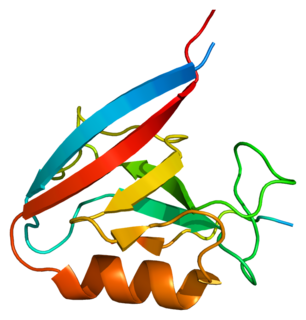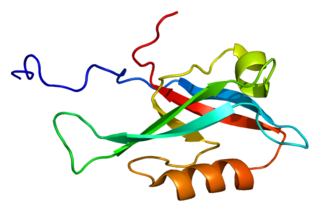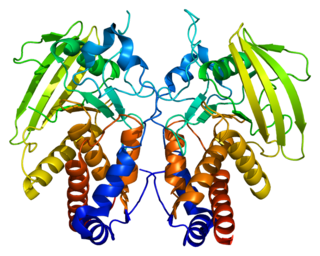
Membrane alanyl aminopeptidase also known as alanyl aminopeptidase (AAP) or aminopeptidase N (AP-N) is an enzyme that in humans is encoded by the ANPEP gene.

Merlin is a cytoskeletal protein. In humans, it is a tumor suppressor protein involved in neurofibromatosis type II. Sequence data reveal its similarity to the ERM protein family.

Erbb2 interacting protein (ERBB2IP), also known as erbin, is a protein which in humans is encoded by the ERBB2IP gene. Discovered in 1997, erbin is a 200kDa protein containing a PDZ domain.

Integrin alpha-5 is a protein that in humans is encoded by the ITGA5 gene.

InaD-like protein is a protein that in humans is encoded by the PATJ gene.

Membrane-associated guanylate kinase, WW and PDZ domain-containing protein 2 also known as membrane-associated guanylate kinase inverted 2 (MAGI-2) and atrophin-1-interacting protein 1 (AIP-1) is an enzyme that in humans is encoded by the MAGI2 gene.

Uroplakin-1a (UP1a) is a protein that in humans is encoded by the UPK1A gene.

Receptor-type tyrosine-protein phosphatase O is an enzyme that in humans is encoded by the PTPRO gene.

PDZ domain-containing protein 2 is a protein that in humans is encoded by the PDZD2 gene.

Protein misato homolog 1 is a protein that in humans is encoded by the MSTO1 gene.

Rh family, B glycoprotein, also known as RHBG, is an ammonia transporter protein which in humans is encoded by the RHBG gene.

Pleckstrin homology domain-containing family A member 1 is a protein that in humans is encoded by the PLEKHA1 gene.

Angiomotin-like protein 1 is a protein that in humans is encoded by the AMOTL1 gene.

Gamma-1-syntrophin is a protein that in humans is encoded by the SNTG1 gene.

Ankyrin-3 (ANK-3), also known as ankyrin-G, is a protein from ankyrin family that in humans is encoded by the ANK3 gene.

Pleckstrin homology domain containing, family G member 5 (PLEKHG5) is a protein that in humans is encoded by the PLEKHG5 gene. Eight transcript variants encoding different isoforms have been found for this gene.

FERM and PDZ domain containing 3 is a protein that in humans is encoded by the FRMPD3 gene.

Fibrinogen C domain containing 1(FIBCD1) is a protein that in humans is encoded by the FIBCD1 gene localized on chromosome 9q34.1 in close proximity to the genes encoding L- and M-ficolin. FIBCD1 is thought to have a role in both host defence and gut homeostasis.

FERM and PDZ domain containing 4 is a protein that in humans is encoded by the FRMPD4 gene.

Inositol polyphosphate-5-phosphatase F is a protein that in humans is encoded by the INPP5F gene.



















